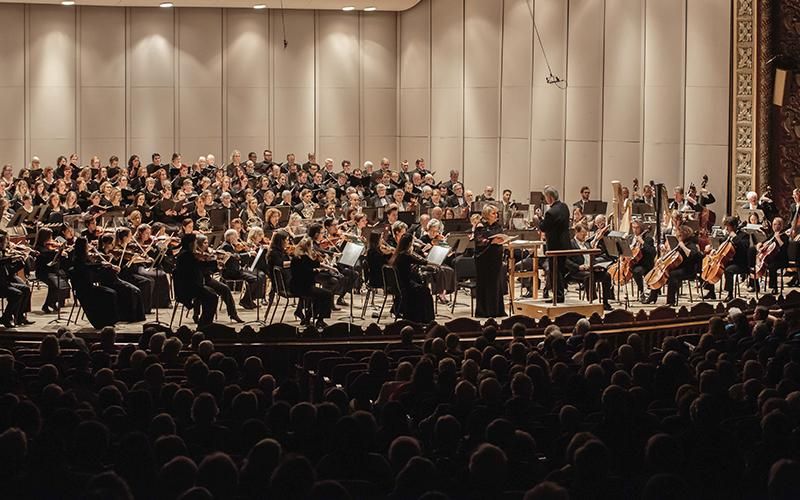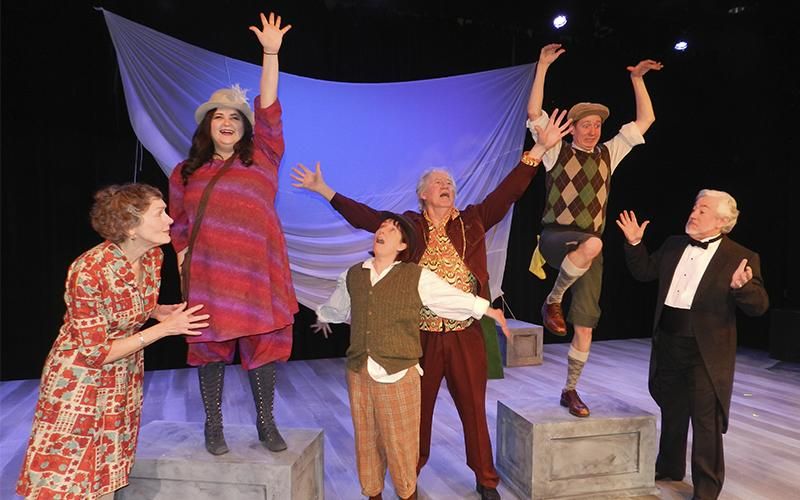For those old enough to remember, the events of September 11, 2001, are forever etched in our minds, with everyone having their story of how they saw the tragedies that day unfold.
But for school-aged children, it’s something they learn as history, something that happened long before they were born.
Adams’ ‘transmigration’
As part of an upcoming performance by the Fort Wayne Philharmonic and Philharmonic Chorus, in collaboration with the Fort Wayne Children’s Choir, the united choirs will perform John Adams’ On the Transmigration of Souls, a piece which deals directly with those events.
The title in itself is telling of Adams’ approach to the work and that day in history.
“One of the things that it’s important to note is that Adams intentionally did not call it a memorial or a requiem,” said Jonathan Busarow, director of the Fort Wayne Children’s Choir. “What he chose to write is about the transmigration of souls, which is about moving from one place to another. The texts that we’re using from 9/11 are from missing persons signs, recordings of messages, and calls made that day to family members. It’s some gut-wrenching stuff.”
Working with one segment of the 300 students who are part of the Fort Wayne Children’s Choir, Busarow is featuring primarily middle school-age children in this performance. He says the topic and rehearsals have been intense.
“The role of the children in the piece is important because in a requiem, children often represent innocence and our best hopes for the future,” Busarow said. “But in this piece they represent the loss of innocence. My students weren’t alive for that event, and they’ve mostly learned about it from a history book. They’re starting to develop an understanding of that day through this piece, and it’s been very eye-opening.”
Joining the Fort Wayne Children’s Choir for the Adams piece will be the Ball State Chamber Choir (under the direction of Andrew Crow) and the Fort Wayne Philharmonic Chorus. Benjamin Rivera, the director of the all-volunteer Chorus, said the challenges for the adults in this performance, those who very much remember that day, are much different.
“This piece is very difficult musically so it’s really necessary for the singers to not get emotionally involved in it. If you allow yourself to get too involved, you can really lose track of what’s on the page. It becomes difficult to count, and you have to be counting — in your head, of course — throughout the entire thing. They aren’t singing on the beat like they usually do. They aren’t coming in on the beat like they usually do. So they really have to become like machines and count continuously. Once you start to think about the horrors of that day and focus on specific details of what’s going on, you’ll lose that focus. This is not one of those pieces that we can enjoy at the same time as the audience does.”
Pivoting to ‘joy’
Following On the Transmigration of Souls” will be Ludwig van Beethoven’s Symphony No. 9 in D Minor: Ode to Joy, an experience that Busarow is looking forward to sharing with his students.
“The Children’s Choir is only performing the Adams piece, and usually we’d pack the kids up and send them home when they are done,” Busarow said. “But I’m planning to have my students stay for the Beethoven performance. I think the juxtaposition of those two pieces is saying something pretty intentional.”
Performing “Ode to Joy” with the Fort Wayne Philharmonic and the Philharmonic Chorus will be the Ball State Concert Choir. Rivera said that the choice is meant to provide some measure of comfort following the Adams piece. But it still manages to provide plenty of challenge for his chorus.
“It definitely is a change in tone,” Rivera said. “But it still provides a ton of challenges for our singers. It’s just a different kind of challenge. The musical language is more familiar although it’s in German so that’s a bit of a challenge for some of our singers who aren’t as comfortable with German.
“But one of the things we have to work on is the text and how to present it. For example, the first word the men sing is ‘Joy.’ You want it to be sung loudly, but if a large group of men sings that loudly, it can sound a bit angry. So you need to work on the sounds of the words to convey the proper meaning.”
Meeting the challenge
Bringing together multiple choirs for one performance provides its own challenges, something that Rivera deals with often in these situations.
“With something like this with the Fort Wayne Children’s Choir or when we work with the Purdue Fort Wayne choir, that’s a bit easier since we’re all in the same town,” Rivera said. “I’ve been able to visit with the Children’s Choir already, but obviously with the Ball State choirs, the travel isn’t possible. So I’ve shared my marked scores with them so they are working from the same information that we are. But the first time we’ll be rehearsing all together will be that Thursday, just two days before the performance, when we do a runthrough with the orchestra.”
Rivera thinks the combination of the Adams and Beethoven pieces will provide an emotionally fulfilling evening of music for the audience. Having once performed “On the Transmigration of Souls” just a couple of years after the events of 9/11, Rivera has had to navigate those raw emotions, still fresh so shortly after the tragedy, and can better conduct his chorus and understand the audience because of it.
“I almost feel guilty telling my singers that they can’t get emotionally involved during that first piece because as musicians you want to communicate. You don’t want to turn part of yourselves off. But having experienced it, it really is necessary to the piece that we focus on the music and not the text. For the audience, I just hope people come with an open heart and let it come at you.
“Don’t try to process it or analyze it intellectually. Let the sound just wash over you. It’s devastating and very difficult, but they’ll get more out of the experience if they let it set the tone for contemplation. It really unlocks your heart.”
 Submit Your Event
Submit Your Event




